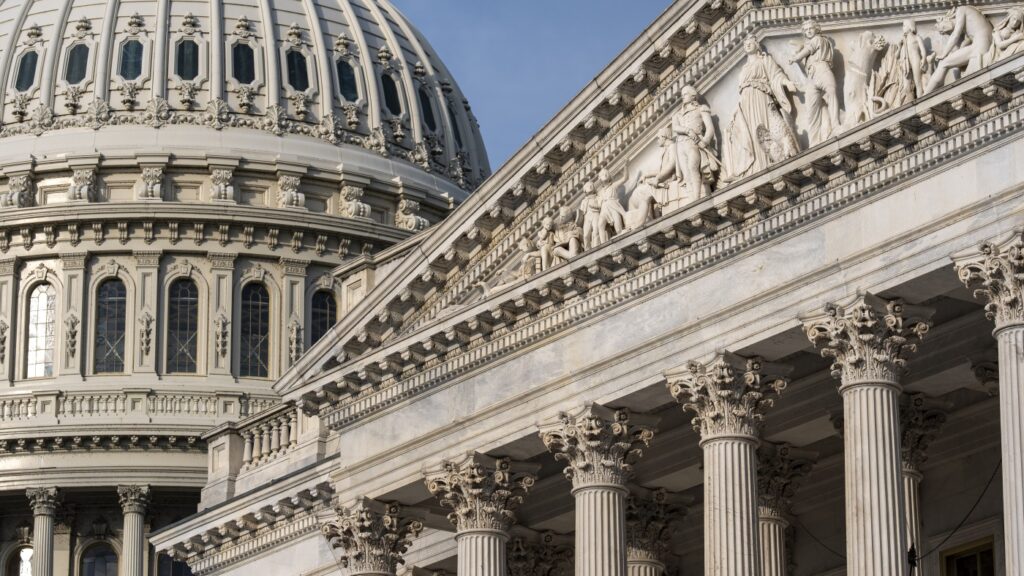
The Senate side of the Capitol is seen in Washington, early Monday, June 30, 2025, as Republicans plan to begin a final push to advance President Donald Trump's big tax breaks and spending cuts package. (AP Photo/J. Scott Applewhite)
In a pivotal move, Senate Republicans passed President Trump’s extensive domestic policy bill, setting up a decisive vote in the House. The legislation aims to cut trillions in taxes while reducing spending on Medicaid, food assistance, and clean energy programs. The Senate’s final vote was 51-50, with Vice President JD Vance casting the tie-breaking vote. Notably, three Republican senators—Susan Collins of Maine, Thom Tillis of North Carolina, and Rand Paul of Kentucky—opposed the bill. The legislation now advances to the House, where it faces potential resistance from some GOP members.
The bill’s passage follows weeks of intense negotiations between fiscal conservatives, who advocated for deeper spending cuts, and other Republicans concerned about the bill’s potential nationwide impact. The legislation seeks to extend the 2017 tax cuts, preventing a potential rate increase at the year’s end. To offset costs, it proposes cuts to the Supplemental Nutrition Assistance Program (SNAP) and significant changes to Medicaid, potentially affecting around 11 million Americans.
Contentious Negotiations and Political Strategy
The bill’s passage highlights President Trump’s influence in unifying the GOP’s disparate factions. Senate Majority Leader John Thune, R-S.D., emphasized the legislation’s alignment with the Republican mandate, stating, “With this legislation, we’re fulfilling the mandate we were entrusted with last November and setting our country and the American people up to be safer, stronger, and more prosperous.”
Despite the Senate’s approval, the bill faces a challenging path before reaching the President’s desk. Republicans utilized a budget tool known as reconciliation to bypass a Democratic filibuster, allowing the bill’s passage with a simple majority. However, the legislation had to adhere to strict Senate rules, requiring all elements to primarily relate to budget and spending, resulting in some GOP priorities being removed before the final vote.
House Challenges and Speaker’s Role
For the bill to become law, the House and Senate versions must align. This presents a significant test for House Speaker Mike Johnson, R-La., who has urged the Senate to minimize changes. Johnson narrowly passed the bill in the House initially, relying on President Trump’s influence to secure last-minute support. With a slim Republican majority, the margin for error remains minimal.
Following the Senate vote, Johnson expressed the House’s commitment to passing the bill by the Fourth of July, stating, “The American people gave us a clear mandate, and after four years of Democrat failure, we intend to deliver without delay.”
Policy Implications and Social Safety Net Cuts
The Senate bill mirrors the House’s version, focusing on extending tax cuts while increasing military and immigration enforcement spending. Both chambers aim to fulfill Trump’s campaign promises, such as eliminating taxes on overtime and tips, albeit temporarily. However, disagreements persist on funding these initiatives, with some House Republicans rejecting Senate changes.
Medicaid is a primary target for savings, with the Senate expanding work requirements to parents of older children. The Senate also addressed concerns over provider taxes, which states use to secure federal Medicaid funds, by introducing a $50 billion fund for rural hospitals starting in 2026. Despite these measures, Senator Collins opposed the bill, citing its detrimental impact on Medicaid and rural healthcare providers.
“I strongly support extending the tax relief for families and small businesses,” Collins stated. “My vote against this bill stems primarily from the harmful impact it will have on Medicaid, affecting low-income families and rural health care providers like our hospitals and nursing homes.”
Deficit Concerns and Economic Impacts
A contentious issue is the proposed increase in the debt ceiling. The House approved a $4 trillion hike, while the Senate opted for $5 trillion. Treasury Secretary Scott Bessent warned Congress of a potential default risk by August without action. The Congressional Budget Office projects the Senate bill will add over $3 trillion to the deficit over the next decade, primarily due to extending the 2017 tax cuts.
The bill also revises the state and local tax (SALT) deduction, crucial for GOP lawmakers in high-tax states. The Senate retained the House’s increased threshold but set it to expire after 2028. Additionally, the bill targets clean energy credits from the Inflation Reduction Act, with the House proposing a rollback that could halt $522 billion in investments, many in red states. The Senate introduced taxes on new wind and solar projects linked to Chinese supply chains to appease fiscal conservatives.
As the bill heads to the House, its fate remains uncertain, with potential implications for millions of Americans and the broader economy. The coming days will be critical as lawmakers navigate the complexities of this sweeping legislation.






